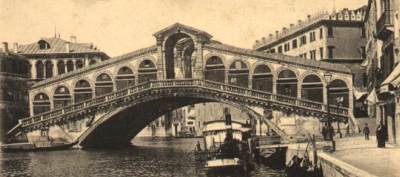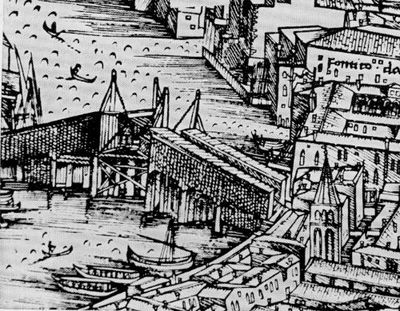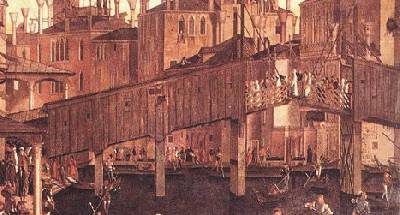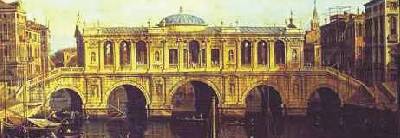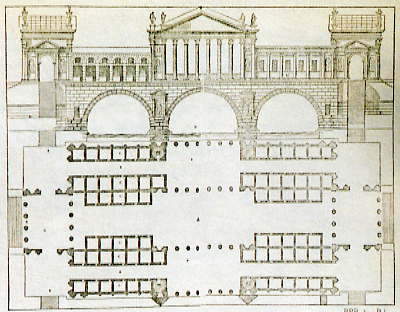Rialto's Bridge
Da Venicewiki, il wiki di Venezia
This page is translated by an automatic translator. If there are any errors please correct them, recording and editing pages. Thanks
Indice |
Description
The Rialto Bridge, that by a wide arch of 28 meters wide and 22 meters high above the line media tide 7.5 meters, crosses the Grand Canal, is and remains the king of all the Venetian bridges.
This bridge sums up in his old name all the glorious history of the life of Venice commercial and seafaring: majestic giant that, as a triumphal arch thrown on the Canalazzo, has always dominated in all popular festivities Venetian and still dominates particularly in Historical Regatta, which assists, silent witness to the passage of the picturesque procession of Bissone, the Gondolas attired in party boats infiorate and fast Gondolini who compete to get the flag, as well as in past centuries was covered with damask drapes to greet the Bucintoro blazing golds and silvers.
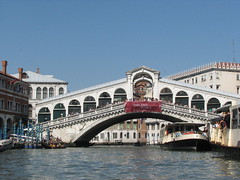
Replaced several times always in wood, is immortalized in 1500 by Jacopo de Barbari with the central opening with a drawbridge to be able to pass the great tree-lined vessels. At the beginning of the XVI Senate century decided that would be built a stone bridge, but fire, pestilence, and war against the turkish postponed the start of work to 1580.
'Only in 1591 the construction of the bridge we see today was completed and was the only bridge in Venice that crossed the Grand Canal until 1854, year of construction of the iron bridge connecting the Field of Charity in Dorsoduro with Campo San Vidal in San Marco District in front of the Academy Gallery just called Bridge Academy
The twelve thousand trunks of elm wood and a host of larch planks that support it, still hold the single arch of over 28 meters of light and the twenty-four accompanying workshops to groups of six ramps on each side, sharing the climbs on a power station, about twenty feet wide, with broad steps grouped in five, and two sides, each about three meters wide, formed by a single endless ramp from the top of the bridge rests.
Two large arches unite at the center of the rows of shops. South on the archivolt, the carved figures of the Angel Gabriel on the one hand, the other of the Virgin in the act to receive the heavenly message, with the Dove between them, reminiscent of the legendary date of foundation of Venice, which occurred, according to ancient tradition, March 25th, the Feast of the Annunciation, in the year 421.
The date is mentioned, along with the construction of the bridge, the epigraph engraved on the four piers.
«Pascale Ciconia Vene tiarum Duce - anno Cristi MDXCI Vrbis conditae MCLXX - curantibus Aloysio Georgio Proc. - M. Barbaro Eq. et Proc. - Jacobo Foscareno Eq. et Proc.»
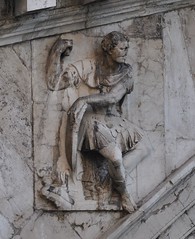
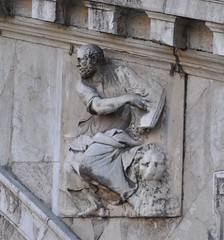
Opposite on the archivolt are carved figures of San Marco with the lion, and San Teodoro, the current and former patron of the city. These aspects are works by Tiziano Aspetti.
The figures of the Annunciation, the Archangel Gabriel, Mary and the dove in the center on the key that seems to transmigrate to Mary by the Archangel, are works by Agostino Rubini, all done just completed the construction the bridge, which was to cost a total of 250,000 ducats, ten times the expenditure for the erection of the previous wooden bridge.


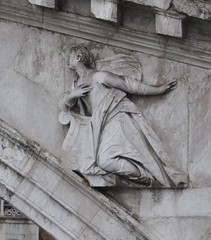
Story
The need to merge the banks of the canal, to make market more accessible, led to the construction of a bridge of boats in 1180, called "Quartarolo" from the name of the coin that was for the pedestrians to cross, as well as the affected Jacopo de Barbari in the popular perspective map dated 1500.Built on pali in 1264, was destroyed in 1310 by conspirators Bajamonte Tiepolo retired after the failed attempt to seize the throne as Duke's last attempt to escape capture and punishment.
Rebuilt in wood, collapsed in 1450 because of the large number of people who flocked to see the shift in Grand Canal of the Marquise of Ferrara.
Was then reconstructed again, but larger, bascule, with shops along its entire length and closed by gates, as is represented by the famous painting Carpaccio, exposed in the Accademia of Venice. Fallen in part in 1524, the Republic of costs in subsequent years, significant digits for the maintenance of the bridge, which being of wood, lasted too little. Banned then a competition for its stone building which was attended by many of the most famous architects of the time. It was a discarded draft Michelangelo, James Sansovino and that of Palladio. The dispute concerned the need for a single arc and had not been divided into three bays.A bridge with shops, should be safe and sound and let the boats pass beneath it, even the greatest, to access the Fontego, the Venetian house with attached warehouse for the storage of goods.
The historical vicissitudes delayed the construction, the plague of 1576 and the fire in Palazzo Ducale in December of 1577 forced the magistrates to postpone the construction of the bridge, so that Canaletto painted the designs of Palladio in a famous whim, as an anticipation of what would have been built later. But not always the story follows the path indicated favorable.Construction began after endless discussions and hesitations, especially to assess the economic interests of the owners of shops on the old bridge in 1588 under the Doge Pasquale Cicogna and the direction was entrusted to Antonio Da Ponte, one of the most talented and Venetian engineers aware of the time, already the author of some restoration work to the Venetian government, such as Palazzo Ducale after the devastating fire of 1577, which was completed in 1592.
Curiosity

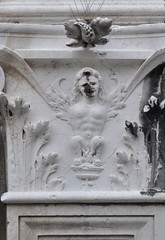
- Among the critics of that time, tells a story popular, there were a man and a woman. The man was saying, « You will not succeed in concluding the construction of this bridge might collapse before being finalized. It will be finished when it - and pointed to the male appendage - put the nail.» The woman exclaimed: « It will never be completed! I bet this - and he pointed to the lower abdomen - I'll burn me if they can finish it!». Maybe they did not know who else had been cast by many centuries arches of much larger size. On the capitals of two pillars of Palazzo dei Camerlenghi, at the foot of the bridge, are two carved bas-reliefs representing a man squatting, with a third leg from the foot markedly unghiato that grows between the two normal, and a woman squatting on the flames . Would, according to tradition, the two opponents crestfallen architect Da Ponte.
- The Rialto Bridge has 42 steps for each side ramp, which are lower than those central to allow trucks to transport goods to pass through it easily, and twelve to the Riva del Buso, and fifteen to the Riva del Vin, near the Palazzo dei Camerlenghi are 18, to the Riva del Ferro are 15. The central two ramps, however, consist of five groups of five steps each, and six groups of three, for a total of 43, to the market, while to the Campo San Bartolomeo are "only" 37 (5x5 and 4x3). To cross it then you can go down a minimum of 80 steps to a maximum of 120 steps.
Foto
view Panoramic photography of Venice
view Panoramic photography of Venice




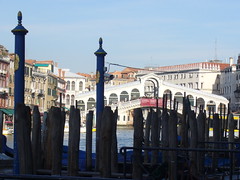
Flickr Error ( Photo not found ): PhotoID 244135825
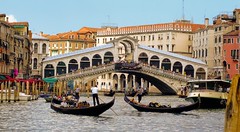
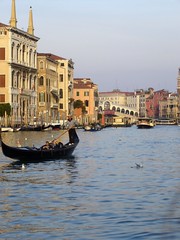



Video
- Apri YouTube
- Individua i video migliori
- Modifica la sezione relativa al video, inserendo il codice di ciascun video (l'ultima parte dell'indirizzo) tra <youtube> e </youtube>.
Esempio:
Per inserire il video che si trova all'indirizzo: http://it.youtube.com/watch?v=vTw8RNnM14k
Basta scrivere: <youtube>vTw8RNnM14k</youtube>
<headertabs />
Categoria: Video
